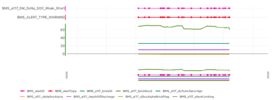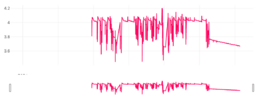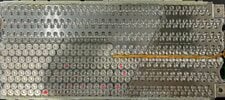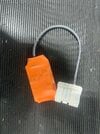So...
We recently had a very interesting situation arise with an out of balance pack that came in with a BMS_u018 imbalance alert and a voltage delta of 120 mV. Pretty standard stuff and we go to work.
Problem was that when we ran the full diagnostics, the CAC was pretty much even across the board and very much in line with the mileage.
But that’s the opposite of how an imbalance would show up, and we couldn’t sort out why the voltage on one brick was completely off. There was no BMS_u029 present, no weak short data on any of the bricks and the BMBs looked good. Maybe one of the bleed resistors on the BMB was stuck open??
Then, one of our techs then suggested that maybe the BMS_u029 has been reset...
So… we log into Toolbox and what so we see? Low and behold, turns out the BMS had detected a weak short and had been spewing out BMS_w117 Weak Short alerts on the low voltage brick for over a month , bleeding about 225 mAh per day, or roughly 0.1% SoC every day, more than enough to trigger a BMS_u029…
, bleeding about 225 mAh per day, or roughly 0.1% SoC every day, more than enough to trigger a BMS_u029…
What's more, about two weeks prior to coming into our service center the pack had thrown an over-voltage error (ie. one of the bricks exceeded 4.2V) and then the BMS begins charge limiting the pack to ~3.62 volts (roughly 48% SoC). Then a few days later the BMS is reset, clearing any weak short data logged internally, the charge limit disappears and the vehicle starts charging again normally... very interesting...
And then finally, a week or two later the BMS suddenly shuts down the pack, this time for good and starts throwing BMS_u018 imbalance alerts as the pack continues to bleed out.
But here's the BIG takeaway, ALL of these details - all the data signals, all the alerts and all the ECU history are now available in the latest version of ToolBox 3 in their Periscope tool (recently renamed CAN Viewer in Toolbox 3) - available for any tech, any dealership, any owner to take to a service center for a Pre-Purchase Inspection (PPI).
Now, for good measure we pulled the defective module and set it up on our new IRQ testing rig and we were able to identify the exact runaway cell in question (red in the last pic), along with a few other cells (in pink) with high, but manageable, Internal Resistance (IR). Turns out the runaway cell was bleeding about 225 mAh per day, or about 8% of its total capacity per day. As a point of reference, a cell like this would normally take 2-3 years to fully discharge - instead with weak short it would fully discharge in less that two weeks - in some cases we've seen them completely drain in less than 24 hours.
All in all, some pretty interesting forensics. What's more, it's now all available to any tech, dealership or owner.
As they say, ‘sunlight is the best disinfectant.’
Note: for privacy reasons we've not included dates and/or ECU reset details.
We recently had a very interesting situation arise with an out of balance pack that came in with a BMS_u018 imbalance alert and a voltage delta of 120 mV. Pretty standard stuff and we go to work.
Problem was that when we ran the full diagnostics, the CAC was pretty much even across the board and very much in line with the mileage.
But that’s the opposite of how an imbalance would show up, and we couldn’t sort out why the voltage on one brick was completely off. There was no BMS_u029 present, no weak short data on any of the bricks and the BMBs looked good. Maybe one of the bleed resistors on the BMB was stuck open??
Then, one of our techs then suggested that maybe the BMS_u029 has been reset...
So… we log into Toolbox and what so we see? Low and behold, turns out the BMS had detected a weak short and had been spewing out BMS_w117 Weak Short alerts on the low voltage brick for over a month
What's more, about two weeks prior to coming into our service center the pack had thrown an over-voltage error (ie. one of the bricks exceeded 4.2V) and then the BMS begins charge limiting the pack to ~3.62 volts (roughly 48% SoC). Then a few days later the BMS is reset, clearing any weak short data logged internally, the charge limit disappears and the vehicle starts charging again normally... very interesting...
And then finally, a week or two later the BMS suddenly shuts down the pack, this time for good and starts throwing BMS_u018 imbalance alerts as the pack continues to bleed out.
But here's the BIG takeaway, ALL of these details - all the data signals, all the alerts and all the ECU history are now available in the latest version of ToolBox 3 in their Periscope tool (recently renamed CAN Viewer in Toolbox 3) - available for any tech, any dealership, any owner to take to a service center for a Pre-Purchase Inspection (PPI).
Now, for good measure we pulled the defective module and set it up on our new IRQ testing rig and we were able to identify the exact runaway cell in question (red in the last pic), along with a few other cells (in pink) with high, but manageable, Internal Resistance (IR). Turns out the runaway cell was bleeding about 225 mAh per day, or about 8% of its total capacity per day. As a point of reference, a cell like this would normally take 2-3 years to fully discharge - instead with weak short it would fully discharge in less that two weeks - in some cases we've seen them completely drain in less than 24 hours.
All in all, some pretty interesting forensics. What's more, it's now all available to any tech, dealership or owner.
As they say, ‘sunlight is the best disinfectant.’
Note: for privacy reasons we've not included dates and/or ECU reset details.
Attachments
Last edited:







